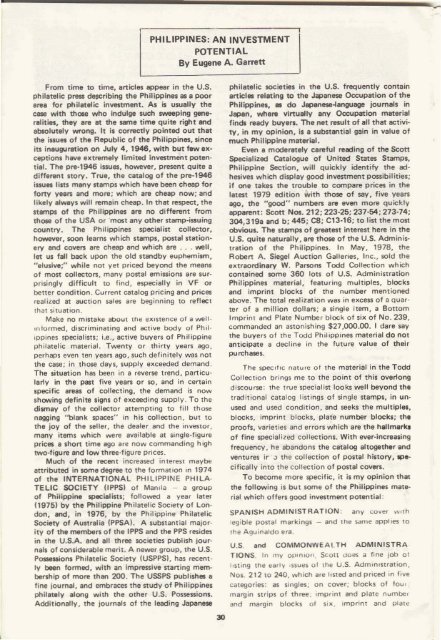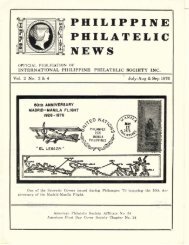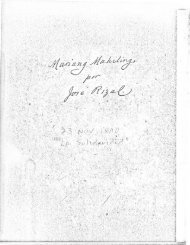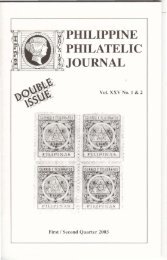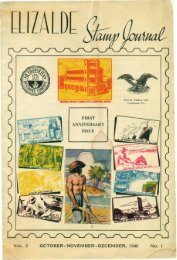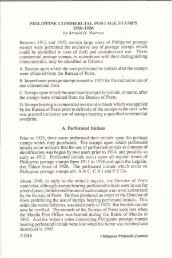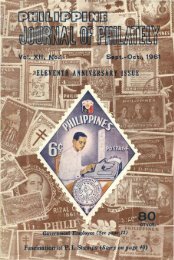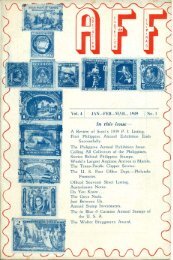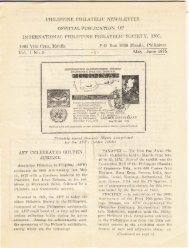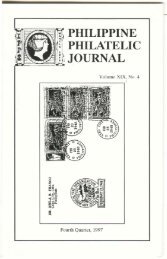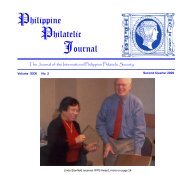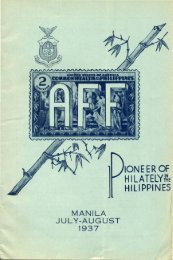June 1979 - International Philippine Philatelic Society
June 1979 - International Philippine Philatelic Society
June 1979 - International Philippine Philatelic Society
Create successful ePaper yourself
Turn your PDF publications into a flip-book with our unique Google optimized e-Paper software.
.....PHILIPPINES: AN INVESTMENTPOTENTIALBy Eugene A. GarrettFrom time to time, articles appear in the U.S.philatelic press d8$Cribing the <strong>Philippine</strong>s as a poorarea for philatelic investment. As is usually thecase w;th those who indulge such sweeping generalities,they are at the same time quite right andabsolutely wrong. It is correctly pointed out thatthe issues of the Republic of the <strong>Philippine</strong>s, sinceits inauguration on July 4, 1946, with but few exceptionshave extremely limited investment poten·tial. The pre-1946 issues, however, present quite adifferent story. True. the catalog of the pre-1946issues lists many stamps which have been cheap forforty years and more; which are cheap now; andlikely always will remain cheap. In that respect, thestamps of the <strong>Philippine</strong>s are no different fromthose of the USA or most any other stamp-issuingcountry. The <strong>Philippine</strong>s specialist collector,however. soon learns which stamps. postal stationaryand covers are cheap and which are ... \Nell,let us fall back upon the old standby euphemism,"elusive;" while not yet priced beyond the meansof most collector1. many postal emissions are surprisinglydifficult to find, especially in VF orbetter condition. Current catalog pricing and pric~realized at auction sales are beginning to reflectthat situation.Make no mistake about the eXIstence of a wellmformed,discriminating and active body of PhilIppines specialists; Le., active buyers of <strong>Philippine</strong>philatelic material. Twenty or thirty years ago,perhaps even ten years ago, such definitely was notthe case; in those days, supply exceeded demand.The situation has been in a reverse trend, particularlyin the past five years or so, and in certainspecific areas of collecting, the demand is nowshovving definite signs of exceeding supply. To thedismay of the collector attempting to fill thosenagging "blank spaces" in his collection, but tothe joy of the seller, the dealer and the investor.many items which were available at single-figureprices a short time ago are now commanding hightwo-figure and low three·figure prices.Much of the recent increased interest maybeattributed in some degree to the formation In 1974of the INTERNATIONAL PHILIPPINE PHILA·TELIC SOCIETY (IPPS) of Mamla - a groupof Phiiippine specialists; followed a year later(1975) by the <strong>Philippine</strong> <strong>Philatelic</strong> <strong>Society</strong> of London,and. in 1976, by the <strong>Philippine</strong> Philateltc<strong>Society</strong> of Australia (PPSA). A substantial majorityof the members of the IPPS and the PPS residesin the U.S.A. and all three societies publish journalsof considerable merit. A newer group, the U.S.Possessions <strong>Philatelic</strong> <strong>Society</strong> IUSPPS). has recentlybeen formed. with an impressive starting membershipof more than 200. The USSPS publishes afine journal, and embraces the study of <strong>Philippine</strong>sphilately along with the other U.S. Possessions.Acktitionally. the journals of the leading Japanese30philatelic societ"s in the U.S. frequently containartk:les relating to the Japanese Occupation of the<strong>Philippine</strong>s, as do Japanese-language journals inJapan, where virtually any Occupation materialfinds ready buyett. The net result of all that activity,in my opinion, is a substantial gain in value ofmuch <strong>Philippine</strong> material.Even a moderately careful reading of the ScottSpecialized Catalogue of United States Stamps,<strong>Philippine</strong> Section. will quickly identify the adhesiveswhk:h display good investment possibilities;if one takes the trouble to compare prices in thelatest <strong>1979</strong> edition with those of say, five yearsago. the "good" numbel'$ are even more quk:klyapparent: Scott Nos. 212; 223-25; 237-54; 273-74;304,3198 and b; 445; C8; C13-16; to list the mostobvious. The stamps of greatest interest here in theU.S. quite naturally. are those of the U.S. Administrationof the <strong>Philippine</strong>s. In May, 1978, theRobert A. Siegel Auction Gallenes, Inc., sold theextraordinary W. Paf$Ons T(Xjd Collection whichcontained some 360 lots of U.S. Administration<strong>Philippine</strong>s material, featuring multiples, blocksand imprint blocks of the number mentionedabove. The total realization was in excess of a quarterof a million dollar1; a single item, a BottomImprint and Plate Number block of six of No. 239,commanded an astonishing $27,000.00. I dare saythe buyers of the Todd <strong>Philippine</strong>s material do notanticipate a decline in the future value of theirpurchases.The specifiC nature of the material in the ToddCollection brings me to the point of this overlongdiscourse: the true specialist looks well beyond thetraditional catalog listings of single stamps. in unusedand used condition, and seeks the multiples,blocks. imprint blocks, plate number blocks; theproofs, varieties and errors which are the hallmark,of fine specialized collections. With ever-increasingfrequency, he abandons the catalog altogether andventures ir ,J the collection of postal history. lPecificallyinto the collection of postal covers.To become more specific, it is my opinion thatthe following is but some of the <strong>Philippine</strong>s materialwhich offers good investment potential:SPANISH ADMINISTRATION: any cover Withlegible postal markings - and the same applies torhe Aguinaldo era.U.S. and COMMONWEALTH ADMINISTRATlONS. In my opmlon. Scott !Joes a fine job oflisting the early ,ssues oj the U.S. Administration,Nos. 212 to 240. which are listed and priced In fivecategories: as Singles; on cover; blocks of fOUlmargin strips of three. Imprint and plate numberand margin blocks of SIX. Imprint and pIaltO'


